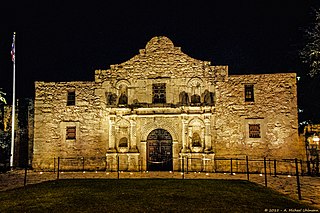The Greater San Antonio area has one of the largest Nigerian American populations in the United States. [1] San Antonio is home to a growing Nigerian community. [2]
A significant number of African immigrants call San Antonio home. Many Nigerians of Igbo origin began leaving Nigeria after the Biafra war of 1967–1970. By the 1980s, San Antonio began receiving many persons of Nigerian origin, forming the Nigerian community in San Antonio. [3] Many Nigerians are currently moving to San Antonio due to affordable cost of living than other major Texas cities and job opportunities. [4] The Nigerian population in San Antonio, Texas, is estimated to be around 10,000 to 15,000 individuals. This number can vary over time due to migration trends and demographic changes.
As of 2000, within the counties of Bexar, Comal, and Medina, there were 7,100 persons who were born in Nigeria, making up about 1% of the total foreign-born population of these three counties. As of 2020 about 150,000 Nigerian Americans live in the San Antonio area. [5]
By 2018, several San Antonio area Nigerians became involved in the home health care business. In 2018, the home healthcare business has attracted Nigerians since it has tremendous income possibilities compared to many other types of jobs and it may allow them to own their own businesses. [6] There are several Nigerian American owned businesses in San Antonio. [7]
As of 2004 large numbers of Nigerian immigrants in the San Antonio area have post-secondary education, and almost all of them had received secondary education. [8] Nigerian immigrants in San Antonio have higher education levels than other immigrant groups and U.S.-born whites. [3]
San Antonio have several Nigerian organizations such as the San Antonio Nigerian Nurses Association, [9] and the Nigeria Peoples Association of San Antonio. [2] The Owerri and Igbo people have ethnic associations in San Antonio.

Texas is the most populous state in the South Central region of the United States. It borders Louisiana to the east, Arkansas to the northeast, Oklahoma to the north, New Mexico to the west, and an international border with the Mexican states of Chihuahua, Coahuila, Nuevo León, and Tamaulipas to the south and southwest. Texas has a coastline on the Gulf of Mexico to the southeast. Covering 268,596 square miles (695,660 km2), and with some 31 million residents as of 2024, it is the second-largest state by both area and population. Texas is nicknamed the Lone Star State for its former status as an independent republic.

San Antonio is a city in the U.S. state of Texas and the most populous city in Greater San Antonio, the third-largest metropolitan area in Texas and the 24th-largest metropolitan area in the United States at 2.6 million people in the 2020 US census. It is the most populous city in and the county seat of Bexar County. The city is the seventh-most populous in the United States, the second-largest in the Southern United States, and the second-most populous in Texas after Houston.
Nigerian Americans are Americans who are of Nigerian ancestry. The number of Nigerian immigrants residing in the United States is rapidly growing, expanding from a small 1980 population of 25,000. The 2022 American Community Survey (ACS) estimated that 712,294 residents of the US were of Nigerian ancestry. The 2019 ACS further estimated that around 392,811 of these (85%) had been born in Nigeria. This puts the American-born Nigerian American population a little over 400,000. Similar to its status as the most populous country in Africa, Nigeria is also the African country with the most migrants to the US, as of 2013. In a study which was carried out by consumer genetics company 23andMe which involved the DNA of 50,281 people of African descent in the United States, Latin America, and Western Europe, it was revealed that Nigeria was the most common country of origin for testers from the United States, the French Caribbean, and the British Caribbean.

In the U.S. state of Texas, Houston is the largest city by both population and area. With a 1850 United States census population of 2,396—and 596,163 a century later, in 1950—Houston's population has experienced positive growth trends. In 2000, the city had a population of 1,953,631 people in 717,945 households and 457,330 families, increasing to 2,304,580 at the 2020 census.
According to the U.S. Census Bureau, as of 2023, Texas was the second largest state in population after California, with a population of 30,503,301, an increase of more than 1.3 million people, or 4.7%, since the 29,145,505 of the 2020 census. Its apportioned population in 2020 was 29,183,290. Since the beginning of the 21st century, the state of Texas has experienced strong population growth. Texas has many major cities and metropolitan areas, along with many towns and rural areas. Much of the population is concentrated in the major cities of Dallas–Fort Worth, Austin, San Antonio, Houston, McAllen, and El Paso and their corresponding metropolitan areas. The first four aforementioned main urban centers are also referred to as the Texas Triangle megaregion.
British Nigerians have formed long-established communities in London, Liverpool and other industrial cities. Many Nigerians and their British-born descendants in Britain live in South London, and they are one of the larger immigrant groups in the country.
African immigration to the United States refers to immigrants to the United States who are or were nationals of modern African countries. The term African in the scope of this article refers to geographical or national origins rather than racial affiliation. From the Immigration and Nationality Act of 1965 to 2017, Sub-Saharan African-born population in the United States grew to 2.1 million people.

Black flight is a term applied to the migration of African Americans from predominantly black or mixed inner-city areas in the United States to suburbs and newly constructed homes on the outer edges of cities. While more attention has been paid to this since the 1990s, the movement of black people to the suburbs has been underway for some time, with nine million people having migrated from 1960 to 2000. Their goals have been similar to those of the white middle class, whose out-migration was called white flight: newer housing, better schools for their children, and attractive environments. From 1990 to 2000, the percentage of African Americans who lived in the suburbs increased to a total of 39 percent, rising 5 percentage points in that decade. Most who moved to the suburbs after World War II were middle class.

Galen College of Nursing is a private for-profit nursing college with multiple locations in the United States.

Indigenous peoples lived in the area now known as Texas long before Spanish explorers arrived in the area. However, once Spaniards arrived and claimed the area for Spain, a process known as mestizaje occurred, in which Spaniards and Native Americans had mestizo children who had both Spanish and indigenous blood. Texas was ruled by Spain as part of its New Spain territory from 1520, when Spaniards first arrived in Mexico in 1520, until Texas won independence from Mexico in 1836, which led to the Treaty of Guadalupe-Hidalgo (1848). In 1830, the Mexican population fell to 20 percent and in 1840 down to 10 percent. When Spanish rule in Texas ended, Mexicans in Texas numbered 5,000. In 1850 over 14,000 Texas residents had Mexican origin.
Occupational health nursing is a specialty nursing practice that provides for and delivers health and safety programs and services to workers, worker populations, and community groups. The practice focuses on promotion, maintenance and restoration of health, prevention of illness and injury, and protection from work‐related and environmental hazards. Occupational health nurses (OHNs) aim to combine knowledge of health and business to balance safe and healthful work environments and a "healthy" bottom line.

There is a rapidly growing Mexican-American population in the Dallas-Fort Worth area.
Dallas–Fort Worth is the most populous metropolitan area of Texas, and the Southern United States. Having 7,637,387 residents at the 2020 U.S. census, the metropolitan statistical area has experienced positive growth trends since the former Dallas and Fort Worth metropolitan areas conurbated into the Metroplex. By the 2022 census estimates, its population grew to 7,943,685.
The Dallas-Fort Worth (DFW) area has a population of Chinese Americans. In the second half of the 19th century, the area became permanently settled by non-Native Americans, and citizens of Chinese descent began to make the area their home as well. In modern times, the main population of Chinese Americans is scattered around the northern suburbs of the City of Dallas.
The Dallas–Fort Worth area has one of the largest Nigerian American populations in the United States.
The African American population in San Antonio, Texas has been a significant part of the city's community since its founding. African Americans have been a part of the Greater San Antonio's history since the late 1800s. San Antonio ranks as the top Texas destination city for Black professionals.
The Dallas–Fort Worth metroplex has 1.2 million African-Americans, the 2nd-largest metro population of African-Americans in Texas.
The city of Baltimore, Maryland includes a significant African population. Immigrants from many African countries have settled in Baltimore, including Nigerians, Sudanese, South Sudanese, Liberians, Sierra Leoneans, Kenyans, Ghanaians, Cameroonians, Ethiopians, Eritreans, and Cape Verdeans. Nigerians, Ghanaians, and Ethiopians are the largest African immigrant groups residing in Baltimore. The largest concentration of African immigrants is located in northeast Baltimore. Nigerians are one of the fastest-growing immigrant groups in Maryland, with many Nigerian-Americans living in northwest Baltimore and adjacent suburbs of Baltimore County, such as Parkville, Owings Mills, and Woodlawn.
Gambian Americans are an ethnic group of Americans of Gambian descent. There are about 8000 Gambians living in the United States, involving themselves in activities ranging from business and entrepreneurship to college education. Additionally, during the Atlantic slave trade, many Africans from what is now The Gambia were traded and were subsequently sold by Europeans and Americans into forced labor in the United States. Gambian immigrants arriving in the United States include members of ethnic groups such as the Mandinka, Wolof, Fula, Jola, and Serahule.